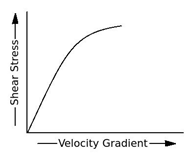This set of Dairy Engineering Multiple Choice Questions & Answers (MCQs) focuses on “Definition and Basic”.
1. Why is it necessary to study flow behavior in dairy?
a) To design food processing plant
b) To prevent spoilage
c) To design food processing plant and prevent spoilage
d) For nutrition
View Answer
Explanation: Study of flow behavior is important for the designing of a food processing plant. In the dairy industry; in particular, there are cream and cultured milk products whose characteristics can be partially or completely spoiled if their flow behavior is not understood.
2. The science of deformation and flow of matter is called _____
a) Welding
b) Bending
c) Tapping
d) Rheology
View Answer
Explanation: Rheology is defined as the science of deformation and flow of matter. Bending is one of the flow behaviors.
3. Consistency can be described as ___________
a) Viscosity
b) Elasticity
c) Breakability
d) Viscosity and elasticity
View Answer
Explanation: Rheologically the consistency is described by two components, the viscosity (“thickness”, lack of slipperiness) and the elasticity (“stickiness”, structure). Breakability is the quality of being easily damaged or destroyed.
4. Rheology stands for viscosity measurements, characterisation of flow behavior and determination of material structure.
a) True
b) false
View Answer
Explanation: Rheology involves viscosity measurements; it involves characterization of flow behavior and determination of material structure. Basic knowledge of these subjects is essential in process design and product quality evaluation.
5. The time required to reduce stress in the material by flow is called __________
a) Peak time
b) Relaxation time
c) Stress time
d) No time
View Answer
Explanation: One way of characterizing a material is by its relaxation time, i.e. the time required to reduce stress in the material by flow. It is important to study the flow behavior of the milk.
6. Milk is a ______ fluid.
a) Viscous
b) Elastic
c) Visco-elastic
d) Extraneous
View Answer
Explanation: Gases and liquids are normally described as viscous fluids. An ideal viscous fluid is unable to store any deformation energy.
7. Which fluids are having a constant viscosity dependent on temperature but independent of the applied shear rate?
a) Non-Newtonian
b) Newtonian
c) Dry
d) Wet
View Answer
Explanation: Newtonian fluids are those having a constant viscosity dependent on temperature but independent of the applied shear rate. Dry and wet are irrelevant.
8. A Newtonian fluid is defined as the fluid which?
a) Obeys hook’s law
b) Is compressible
c) Obey Newton’s law of viscosity
d) Is incompressible
View Answer
Explanation: Newtonian fluid is defined as the fluid which obeys Newton’s law of viscosity for a Newtonian fluid. The viscosity curve, which is a plot of viscosity versus shear rate, will show a straight line at a constant value equal to h.
9. Property of fluid that describes its internal resistance is known as __________
a) Viscosity
b) Friction
c) Resistance
d) Internal energy
View Answer
Explanation: Property of fluid that describes its internal resistance is called viscosity. Friction is the force resisting the relative motion of fluid layers.
10. Stress strain relationship for a Newtonian fluid is __________
a) Hyperbolic
b) Parabolic
c) Linear
d) Inverse type
View Answer
Explanation: Newtonian fluid has a linear stress strain relationship. The increase in stress directly corresponds to increase in strain.
11. For non-Newtonian fluids, apparent viscosity is a function of __________
a) shear rate
b) flow rate
c) viscous rate
d) specific rate
View Answer
Explanation: Non Newtonian fluid apart from being shear rate dependent.T he viscosity of non-Newtonian fluids may also be time dependent.
12. The diagram below is a graph of change in shear stress with respect to velocity gradient in a fluid. What is a type of the fluid?

a) Newtonian
b) Non Newtonian
c) Ideal
d) Dilated
View Answer
Explanation: The above diagram represents the relationship between Shear stress and velocity gradient of Non- Newtonian fluid. It is non-linear.
13. Which of the following are now Newtonian material which is time independent?
a) Thixotropic
b) Rheo-pectic
c) Anti-thixotropic
d) Plastic
View Answer
Explanation: Non-Newtonian materials that are time independent are defined as shear thinning. They can also be shear thickening or plastic.
14. Which of the following are now Newtonian materials which are time dependent?
a) Shear thickening
b) Rheo-pectic
c) Shear thinning
d) plastic
View Answer
Explanation: Non-Newtonian materials that are time dependent are defined as thixotropic. They can also be rheopectic or anti-thixotropic.
15. Which among the following is not the example of thixotropic fluid?
a) Yogurt
b) Ice cream
c) Mayonnaise
d) Milk
View Answer
Explanation: Typical examples of thixotropic fluids are yoghurt. Mayonnaise, margarine, ice cream and brush paint also come in the same category.
Sanfoundry Global Education & Learning Series – Dairy Engineering.
To practice all areas of Dairy Engineering, here is complete set of 1000+ Multiple Choice Questions and Answers.
If you find a mistake in question / option / answer, kindly take a screenshot and email to [email protected]
- Apply for Agricultural Engineering Internship
- Check Dairy Engineering Books
- Practice Agricultural Engineering MCQs
- Check Agricultural Engineering Books
